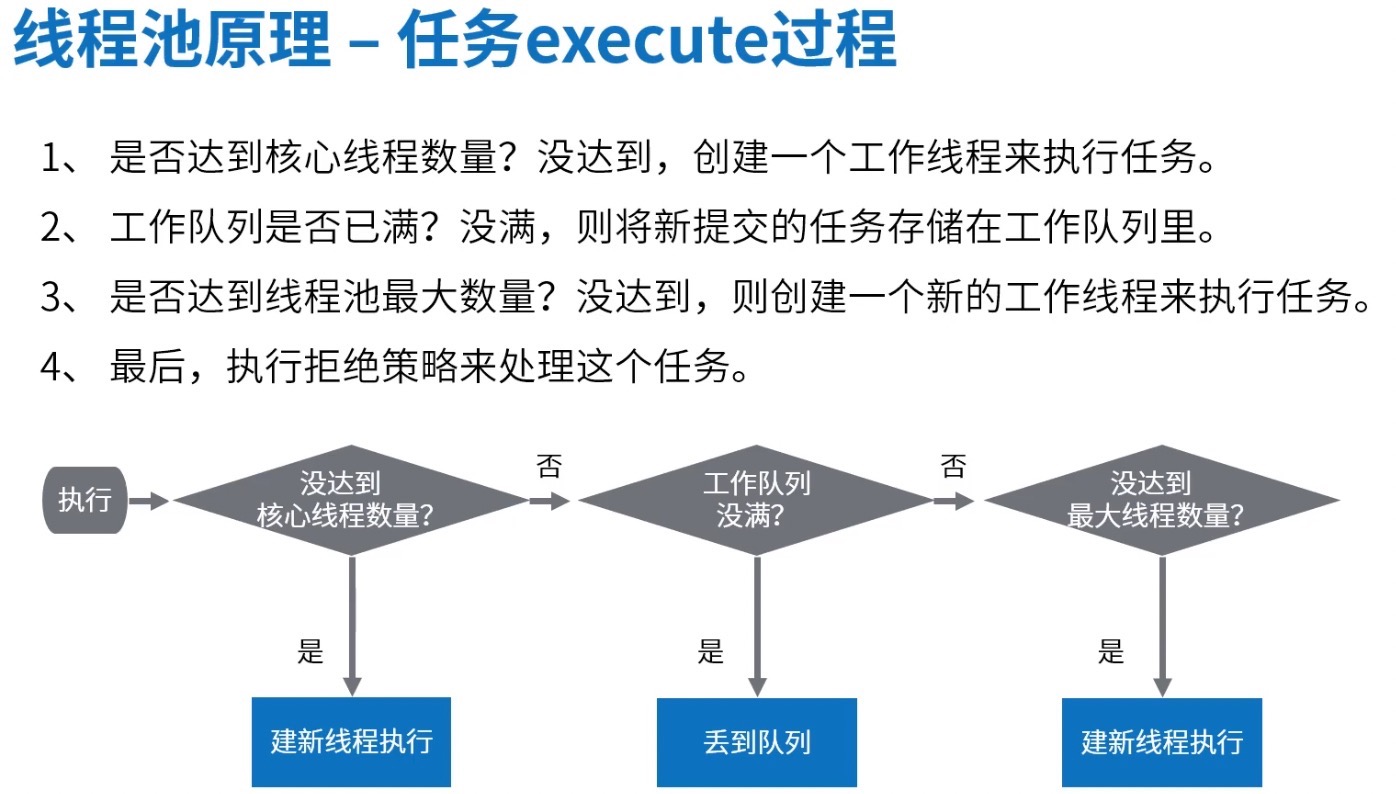线程池ThreadPoolExecutor类源码解析
简介
Executors是java线程池的工厂类,通过它可以快速初始化一个符合业务需求的线程池

线程池状态
1 | /**ctl代表2个含义:高3位代表线程运行状态,低29位代表线程数*/ |
1 | /** |
初始化ThredPoolExecutor
1 | /** |
corePoolSize
线程池中的核心线程数,当你提交一个任务时,线程池会创建一个新线程执行任务,直到当前线程数量等于你定义的corePoolSize;如果当前的线程数为corePoolSize,继续提交的任务会被保留到阻塞队列中,等待被执行。
maximumPoolSize
线程中允许的最大线程数。如果阻塞队列满了,且继续提交任务的时候,则创建新的线程执行任务,前提是当前线程数必须小于maximumPoolSize。maximumPoolSize必须大于corePoolSize。
keepAliveTime
线程空闲时的存活时间,即当线程没有任务执行时,继续存活的时间;默认情况下,该参数只在线程数大于corePoolSize时才会有用。
unit
keepAliveTime的单位
workQueue
用来保存等待被执行的任务的阻塞队列,且任务必须实现Runnable接口,在JDK中提供了如下阻塞队列:
1、ArrayBlockingQueue:基于数组结构的有界阻塞队列,按FIFO排序任务;
2、LinkedBlockingQuene:基于链表结构的阻塞队列,按FIFO排序任务,吞吐量通常要高于ArrayBlockingQuene;
3、SynchronousQuene:一个不存储元素的阻塞队列,每个插入操作必须等到另一个线程调用移除操作,否则插入操作一直处于阻塞状态,吞吐量通常要高于LinkedBlockingQuene;
4、priorityBlockingQuene:具有优先级的无界阻塞队列;
threadFactory
创建线程的工厂,通过自定义的线程工程可以给每个线程创建一个具有辨识度的名字。(位于ThreadFactory实现类Executors的内部类DeaultThreadFactory)
1 | DefaultThreadFactory() { |
handler
线程池饱和策略,当阻塞队列满了,且没有空闲的工作线程,如果继续提交任务,必须采取一种策略处理该任务,线程池提供了4种策略。
1、AbortPolicy:直接抛出异常,默认策略;
2、CallerRunsPolicy:用调用者所在的线程来执行任务;
3、DiscardOldestPolicy:丢弃阻塞队列中靠最前的任务,并执行当前任务;
4、DiscardPolicy:直接丢弃任务;
当然也可以根据应用场景实现RejectedExecutionHandler接口,自定义饱和策略,如记录日志或持久化存储不能处理的任务。
核心代码流程

execute() – 提交任务
1 | /** |
addWorker() – 添加worker线程
1 | /** |
addWorker(Runnable firstTask, boolean core)
参数:
firstTask: worker线程的初始任务,可以为空
core: true:将corePoolSize作为上限,false:将maximumPoolSize作为上限
addWorker方法有4种传参的方式:
1、addWorker(command, true)
2、addWorker(command, false)
3、addWorker(null, false)
4、addWorker(null, true)在execute方法中就使用了前3种,结合这个核心方法进行以下分析
第一个:线程数小于corePoolSize时,放一个需要处理的task进Workers Set。如果Workers Set长度超过corePoolSize,就返回false
第二个:当队列被放满时,就尝试将这个新来的task直接放入Workers Set,而此时Workers Set的长度限制是maximumPoolSize。如果线程池也满了的话就返回false
第三个:放入一个空的task进workers Set,长度限制是maximumPoolSize。这样一个task为空的worker在线程执行的时候会去任务队列里拿任务,这样就相当于创建了一个新的线程,只是没有马上分配任务
第四个:这个方法就是放一个null的task进Workers Set,而且是在小于corePoolSize时,如果此时Set中的数量已经达到corePoolSize那就返回false,什么也不干。实际使用中是在prestartAllCoreThreads()方法,这个方法用来为线程池预先启动corePoolSize个worker等待从workQueue中获取任务执行
执行流程:
1、判断线程池当前是否为可以添加worker线程的状态,可以则继续下一步,不可以return false:
A、线程池状态>shutdown,可能为stop、tidying、terminated,不能添加worker线程
B、线程池状态==shutdown,firstTask不为空,不能添加worker线程,因为shutdown状态的线程池不接收新任务
C、线程池状态==shutdown,firstTask==null,workQueue为空,不能添加worker线程,因为firstTask为空是为了添加一个没有任务的线程再从workQueue获取task,而workQueue为空,说明添加无任务线程已经没有意义
2、线程池当前线程数量是否超过上限(corePoolSize 或 maximumPoolSize),超过了return false,没超过则对workerCount+1,继续下一步
3、在线程池的ReentrantLock保证下,向Workers Set中添加新创建的worker实例,添加完成后解锁,并启动worker线程,如果这一切都成功了,return true,如果添加worker入Set失败或启动失败,调用addWorkerFailed()逻辑
worker() – 内部类
1 | /** |
Worker类
Worker类本身既实现了Runnable,又继承了AbstractQueuedSynchronizer(以下简称AQS),所以其既是一个可执行的任务,又可以达到锁的效果
new Worker()
1、将AQS的state置为-1,在runWoker()前不允许中断
2、待执行的任务会以参数传入,并赋予firstTask
3、用Worker这个Runnable创建Thread
之所以Worker自己实现Runnable,并创建Thread,在firstTask外包一层,是因为要通过Worker控制中断,而firstTask这个工作任务只是负责执行业务
Worker控制中断主要有以下几方面:
1、初始AQS状态为-1,此时不允许中断interrupt(),只有在worker线程启动了,执行了runWoker(),将state置为0,才能中断
不允许中断体现在:
A、shutdown()线程池时,会对每个worker tryLock()上锁,而Worker类这个AQS的tryAcquire()方法是固定将state从0->1,故初始状态state==-1时tryLock()失败,没发interrupt()
B、shutdownNow()线程池时,不用tryLock()上锁,但调用worker.interruptIfStarted()终止worker,interruptIfStarted()也有state>0才能interrupt的逻辑
2、为了防止某种情况下,在运行中的worker被中断,runWorker()每次运行任务时都会lock()上锁,而shutdown()这类可能会终止worker的操作需要先获取worker的锁,这样就防止了中断正在运行的线程
Worker实现的AQS为不可重入锁,为了是在获得worker锁的情况下再进入其它一些需要加锁的方法
Worker和Task的区别:
Worker是线程池中的线程,而Task虽然是runnable,但是并没有真正执行,只是被Worker调用了run方法,后面会看到这部分的实现。
runWorker() – 执行任务
1 | /** |
runWorker(Worker w)
执行流程:
1、Worker线程启动后,通过Worker类的run()方法调用runWorker(this)
2、执行任务之前,首先worker.unlock(),将AQS的state置为0,允许中断当前worker线程
3、开始执行firstTask,调用task.run(),在执行任务前会上锁wroker.lock(),在执行完任务后会解锁,为了防止在任务运行时被线程池一些中断操作中断
4、在任务执行前后,可以根据业务场景自定义beforeExecute() 和 afterExecute()方法
5、无论在beforeExecute()、task.run()、afterExecute()发生异常上抛,都会导致worker线程终止,进入processWorkerExit()处理worker退出的流程
6、如正常执行完当前task后,会通过getTask()从阻塞队列中获取新任务,当队列中没有任务,且获取任务超时,那么当前worker也会进入退出流程
getTask() – 获取任务
1 | /** |
getTask()
执行流程:
1、首先判断是否可以满足从workQueue中获取任务的条件,不满足return null
A、线程池状态是否满足:
(a)shutdown状态 + workQueue为空 或 stop状态,都不满足,因为被shutdown后还是要执行workQueue剩余的任务,但workQueue也为空,就可以退出了
(b)stop状态,shutdownNow()操作会使线程池进入stop,此时不接受新任务,中断正在执行的任务,workQueue中的任务也不执行了,故return null返回
B、线程数量是否超过maximumPoolSize 或 获取任务是否超时
(a)线程数量超过maximumPoolSize可能是线程池在运行时被调用了setMaximumPoolSize()被改变了大小,否则已经addWorker()成功不会超过maximumPoolSize
(b)如果 当前线程数量>corePoolSize,才会检查是否获取任务超时,这也体现了当线程数量达到maximumPoolSize后,如果一直没有新任务,会逐渐终止worker线程直到corePoolSize
2、如果满足获取任务条件,根据是否需要定时获取调用不同方法:
A、workQueue.poll():如果在keepAliveTime时间内,阻塞队列还是没有任务,返回null
B、workQueue.take():如果阻塞队列为空,当前线程会被挂起等待;当队列中有任务加入时,线程被唤醒,take方法返回任务
3、在阻塞从workQueue中获取任务时,可以被interrupt()中断,代码中捕获了InterruptedException,重置timedOut为初始值false,再次执行第1步中的判断,满足就继续获取任务,不满足return null,会进入worker退出的流程
processWorkerExit() – worker线程退出
1 | /** |
processWorkerExit(Worker w, boolean completedAbruptly)
参数:
worker: 要结束的worker
completedAbruptly: 是否突然完成(是否因为异常退出)
执行流程:
1、worker数量-1
A、如果是突然终止,说明是task执行时异常情况导致,即run()方法执行时发生了异常,那么正在工作的worker线程数量需要-1
B、如果不是突然终止,说明是worker线程没有task可执行了,不用-1,因为已经在getTask()方法中-1了
2、从Workers Set中移除worker,删除时需要上锁mainlock
3、tryTerminate():在对线程池有负效益的操作时,都需要“尝试终止”线程池,大概逻辑:
判断线程池是否满足终止的状态
A、如果状态满足,但还有线程池还有线程,尝试对其发出中断响应,使其能进入退出流程
B、没有线程了,更新状态为tidying->terminated
4、是否需要增加worker线程,如果线程池还没有完全终止,仍需要保持一定数量的线程
线程池状态是running 或 shutdown
A、如果当前线程是突然终止的,addWorker()
B、如果当前线程不是突然终止的,但当前线程数量 < 要维护的线程数量,addWorker()
故如果调用线程池shutdown(),直到workQueue为空前,线程池都会维持corePoolSize个线程,然后再逐渐销毁这corePoolSize个线程